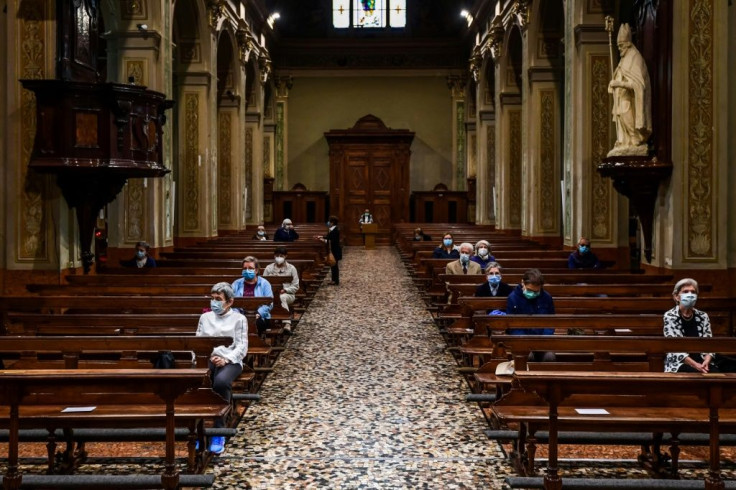Learning To Live Again In Italy's First Virus Red Zone
It was the first town in Europe to be placed in lockdown over the coronavirus. Now life in Codogno is gradually returning to normal, but the scars left by the pandemic will be slow to heal.
The sun is shining on cobbled piazzas and terraces in this town of 15,000, where locals wearing masks whizz around on bicycles, making the most of the lifting of the lockdown.
Shops, restaurants, cafes and hairdressers across Italy were allowed to open from Monday, as the country slowly emerges from an economically-crippling national shutdown and a pandemic that has killed over 32,000 people there.

In front of the yellow, red and pink buildings that face onto Codogno's main square, young Italians could be seen enjoying iced coffees while bells summoned people to mass at the large red-brick church.
"Discovering that the virus we'd heard so much about in China was here had a huge psychological impact," lawyer Maria Luisa Brizzolari, 46, told AFP as she looked back at the moment their lives changed.
"It seemed like something so far away, and yet it was here among us," she said.
The small in northern Italy was home to a 38-year-old man, Mattia Maestri, who came to be dubbed Italy's "patient one".

The otherwise-healthy athlete turned up in Codogno hospital's emergency room on February 18 suffering a fever, cough and shortness of breath. His condition deteriorated.
Two days later he was tested for COVID-19. It came back positive. His pregnant wife also had it and his father would later die of it. A flurry of other cases emerged in people who had frequented the hospital or local cafes.
Maestri had not travelled and still doesn't know where he picked up the virus.

On February 21 the government designated Codogno a so-called red zone and ordered it shuttered, followed by nine other towns across Lombardy and the Veneto.
"It was a more ferocious war than the ones you fight, where you can see your enemy," said pensioner Giancarlo Barcelesi.
"This time the enemy was invisible," he said.

Religious celebrations were allowed to begin again this week, though the faithful were seated far apart, just one to a pew.
Priest Iginio Passerini, 72, said his parishioners were finally beginning to breathe more easily, but the town would not forget.
It had no chance to, said student Paula Visigalli, 20, because it would be forever linked in people's minds to the virus.
"It's seen as a plague town," she said.
"I hear people want to come and see where it happened, but Codogno is just a normal town like any other," she added.
Brizzolari, the lawyer, disagreed and pointed out that the town had suffered a longer lockdown than the rest of Italy.
"Codogno will always be linked to the coronavirus, but that could also be a way to remember the strength of the local population," she said.
Others were worried that the easing of strict anti-infection measures would allow the virus to begin to spread again.
"Everyone's afraid of having to go back into lockdown, of having to fear contact between people, of it all happening again," said bartender Laura Sbardi, 25.
Shopkeeper Cesare Gambazza was one of many who said people seemed "too relaxed".
"They think it's finished, but we don't know that," he said.
Fanny Zafferri, a 54-year-old nurse who worked with coronavirus patients earlier in the pandemic, recalled those "chaotic, scary" first days at the hospital.
She fears those days may return.
"I'm a bit scared of people's behaviour, to be honest. It was better during the lockdown," she said.
© Copyright AFP 2024. All rights reserved.





















